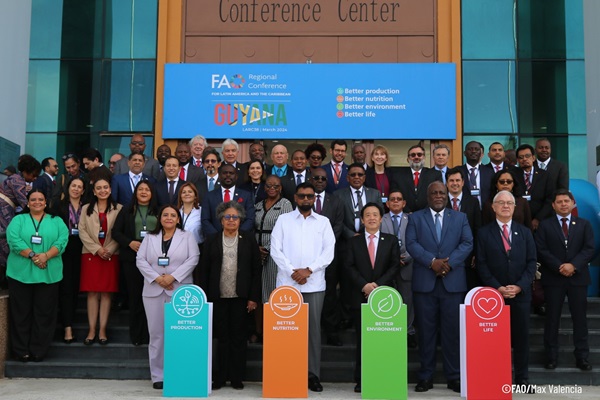FAO Members in Latin America and the Caribbean discuss how to reduce hunger and inequality in world’s largest agrifood exporting region
Georgetown, Guyana – Protecting the poorest, reducing inequalities, improving food security and nutrition, and improving market access are among key goals in Latin America and the Caribbean, a region that makes major contributions to global food security, QU Dongyu, Director-General of the Food and Agriculture Organization of the United Nations (FAO), highlighted in his opening remarks at the Ministerial Session of 38th FAO Regional Conference for Latin America and the Caribbean.
“You have big potential to accelerate progress, and to do even more with less within and outside your region,” he said, noting the region boasts a large share of the world’s biodiversity and water resources and accounts for 13 percent of global food production and 45 percent of net international trade in agrifood products.
Qu also noted that, although the region is a net food exporter, the reliance on commodity imports and exports exposes its agrifood systems to macroeconomic volatility, global geopolitical instability, and climate change, which in turn negatively impact food prices and incomes and lead to unfavourable food security and nutrition outcomes.
According to FAO's latest estimates, the prevalence of undernourishment in the region remains higher than in 2019 as a result of COVID-19, even though it decreased to 6.5 percent in 2022, from 7.0 percent in 2021, which means that 2.4 million people are no longer suffering from hunger. This is the highest decrease among all regions of the world. However, such progress has occurred in South America (from 7.0 percent to 6.1 percent), while the prevalence of hunger has remained almost the same in Mesoamerica (from 5.0 percent to 5.1 percent). In the Caribbean, undernourishment has risen, from 14.7 percent in 2021 to 16.3 percent in 2022.
These statistics only scratch the surface of the current challenges facing agrifood systems in the region, which include the impacts of the climate crisis, economic disparities, and an over-dependence on commodities.
Mohamed Irfaan Ali, President of Guyana, said that creating resilient and climate-protected agrifood systems is an imperative task going forward, and “decision making must be data driven as far as possible,” he said. He also called for a greater focus on nutrition and a shift “back to the bowl from the box.”
FAO’s Director-General urged countries to share best practices and leverage the momentum offered by the Conference to work together and with FAO to set tangible targets and “accelerate and strengthen collective efforts towards transforming agrifood systems in the region and beyond.”
Zulfikar Mustapha, Guyana’s Minister of Agriculture and Chairperson of this Regional Conference, highlighted progress made in some landmark initiatives in his country, including notably increased production in animal proteins, entrepreneurial incentives for younger people and a commitment towards increased integration of regional agrifood trade.
Multilateral approaches
Emphasizing the importance of Latin America and the Caribbean as a key provider of surplus agrifood output to global markets, the Director-General stressed that FAO aims to mitigate the negative impacts of price shocks on food costs and to prevent disruptions in supply chains, both areas of work that support Members and their policy decisions and measures to produce more with less.
Even stronger partnerships are needed for more successful impact at scale, he said, noting that the poor, through lost income and higher prices, always bear a disproportionate burden of disruption to agrifood systems.
Qu also highlighted that the G20 under the Presidency of Brazil in 2024 provides a unique opportunity to advocate for the eradication of hunger and reduction of inequalities. In this context, FAO strong supports the proposed G20 Task Force for the Global Alliance Against Hunger and Poverty, he said.
The new Food Security, Nutrition and Hunger Eradication Plan of the Community of Latin American and Caribbean (CELAC) is also an important contribution to tackling current agrifood systems challenges through regional integration, he added.
Regional path forward
The Regional Conference features Ministerial Roundtables focusing on how to advance fisheries and aquaculture under the Blue Transformation approach, harnessing trade as a strategic deriver to reduce hunger and malnutrition in the region, and addressing the challenges of the water-forest-biodiversity-soil nexus in the context of climate change.
High-level special events will also be held focusing on how to science and digital innovation can bolster family farming, the need for agrifood systems transformation in the region’s Small Island Developing States, investment targeting through FAO’s Hand in Hand Initiative, and foresight drivers and triggers relevant for Latin America and the Caribbean.
At the Regional Ministerial Conference, the discussions will also focus on four interconnected regional priorities reflecting the “four betters” set out in the Organization's Strategic Framework 2022-31 – better production, better nutrition, a better environment, and a better life, leaving no one behind. These priorities aim to catalyze the transformation of agrifood systems by enhancing efficiency, inclusivity, and sustainability in production; eradicating hunger and advancing food security and nutrition; promoting the sustainable management of natural resources and adaptation to the climate crisis; and addressing inequalities, poverty, and fostering resilience.
FAO’s Hand-in-Hand Initiative is currently collaborating with 14 countries in Latin American and the Caribbean, developing investment plans totalling around $772 million as well as pushing forward regional initiatives for the Dry Corridor, the Panama hub, and Amazonia.
The FAO 1000 Digital Villages Initiative currently supports 52 agritourism projects in 14 countries in the region.
The FAO One Country One Priority Product initiative is promoting 11 Special Agricultural Products in 14 countries in the region.
The Regional Technical Platform on Family Farming has successfully connected participants from more than 40 countries around the world.
Qu also outlined how FAO’s approach is built around crafting comprehensive strategies aimed at advancing inclusive rural development and sustainable natural resource management, enhancing resilience among the most vulnerable populations, and sharpening programmatic work with Small Island Developing States.
